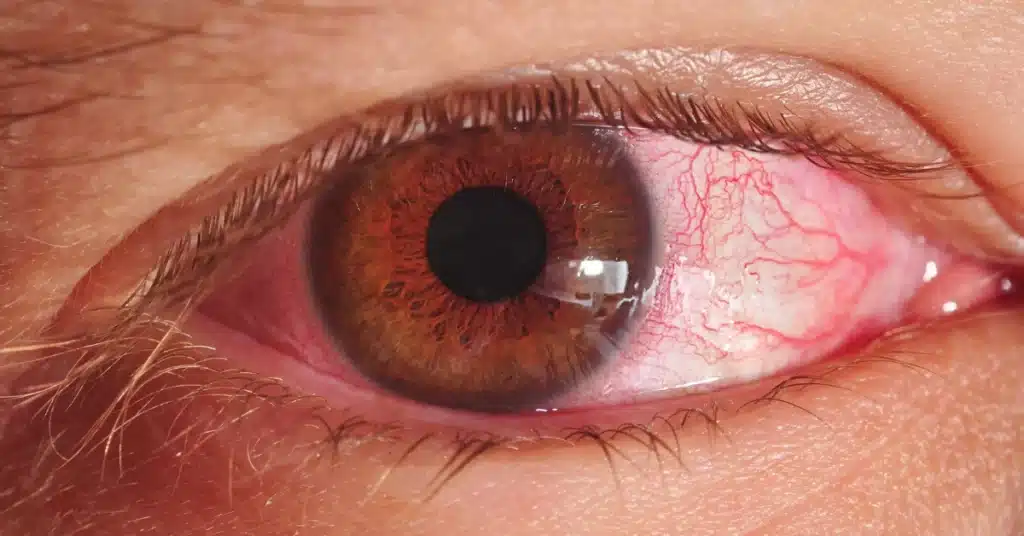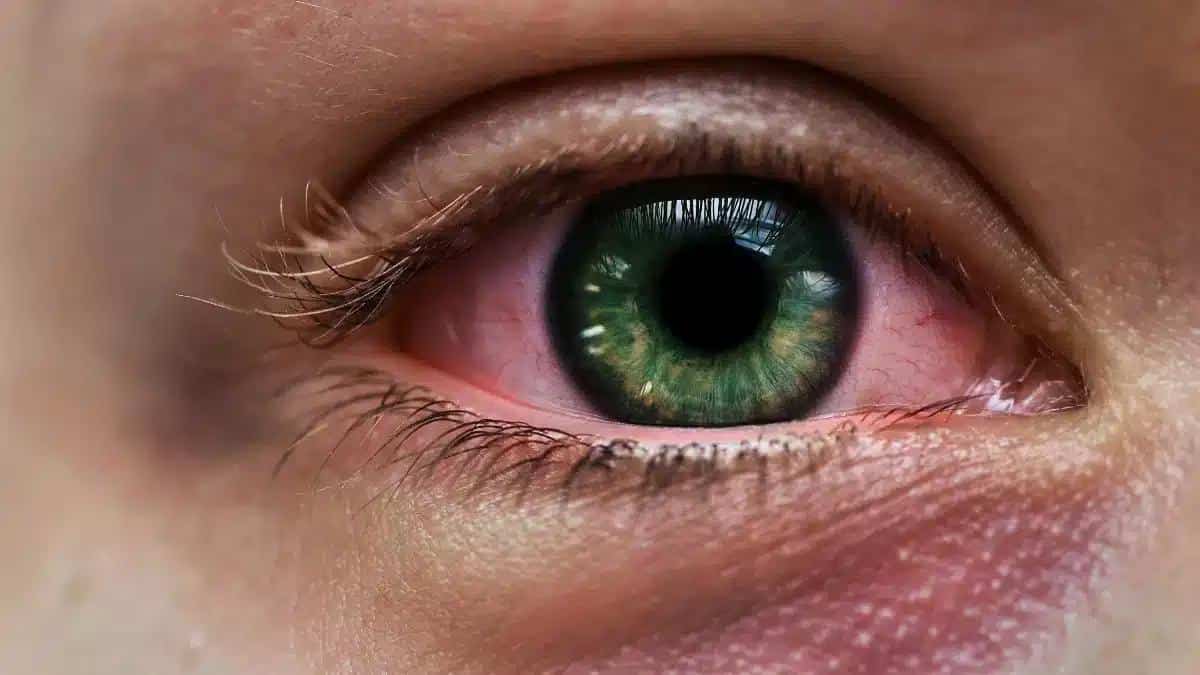Eye infections are a common ocular health issue affecting people of all ages.
Eye infection are often caused by viruses, bacteria, fungi, or other allergens, and they can hurt our eyes, turn them red, and blur our vision.
In this article, we will talk about the types of eye infections, their symptoms, causes, and available treatment options.
Defining eye infection
An eye infection occurs due to microorganisms like mold or bacteria. Most of the time, these germs are viruses, bacteria, and fungi.
These diseases might show up in one eye or both eyes simultaneously.
The seriousness of these eye infections depends on their causative agent; some may need to be treated immediately by a doctor.
Antibiotics and antihistamines are two effective treatments that can help with these eye illnesses.
Want to know more about antibiotics for eye infection? Read our article: Understanding Antibiotics for Eye Infections
Types of eye infections
Eye infections are common; every year, they affect about 1 million people in the US. People who use contact lenses are more likely to get these illnesses.
Keratitis is the second most common eye illness, after Conjunctivitis, also known as “Pink Eye.”
Let’s look at these common eye infections from the point of view of where they come from to get a better idea
Viral eye infection
 Source: dtimiraos_from_Getty_Images
Source: dtimiraos_from_Getty_ImagesSeveral viruses affect our eyes, causing viral eye infections. Some of these viruses are Adenovirus and Herpes Simplex.
Some of the most common viral eye illnesses are Pink Eye, Keratitis, and Uveitis.
More often than not, viral Pink Eye causes eye pain marked by redness and itching.
Want to know more about viral eye infection? Read our article: Viral Eye Infection: Causes, Symptoms, and Treatment Options
Bacterial eye infection
As you might guess from the name, bacterial eye diseases are caused by certain bacteria.
Staphylococcus aureus, streptococcus pneumoniae, and Pseudomonas aeruginosa are some of the bacteria that can cause eye infections.
Many people get bacterial eye diseases like bacterial Pink Eye (Conjunctivitis), Keratitis, Blepharitis, Uveitis, and Sties.
Even though Pink Eye and Stye may have some of the same symptoms, they are two different eye infections.
Learn everything about bacterial eye infection, read our article: Bacterial Eye Infections: Symptoms, Types, and Treatments
Fungal eye infection
Fungal eye infections result from exposure to fungi, posing a risk to ocular health.
Fungal eye infections can be very bad, even though they occur less frequently than bacterial or viral infections.
Fungi like Aspergillus and Candida are the main cause of fungal eye infections.
Explore more about the various types of eye infections. Read our article: Exploring the Various Types of Eye Infections: A Comprehensive Guide
Eye infection symptoms
 Source: piotr_malczyk
Source: piotr_malczykSymptoms of an eye infection depend upon the type and severity of the illness. Inflamed blood vessels cause redness, which is a sign of eye infection.
When it comes to infections like allergic Conjunctivitis, symptoms include itching and discomfort.
When you have a bacterial or viral illness, your eyes will often have discharge, which can be clear, yellow, or greenish.
Pain and sensitivity to light (Photophobia) could be symptoms of Keratitis which is a more serious eye infection.
Vision changes, like blurriness, must be taken care of immediately.
If you think you have something stuck in your eye or experience pain all the time, you should get a full checkup.
Noticing these symptoms helps detect the problem early and decide the right treatment.
Over-the-counter medicines can help with minor cases, but consult a doctor if symptoms persist or are severe.
Read our article: Eye Infection Symptoms & Signs to Watch Out For to know more about the various eye infection symptoms
Eye infection causes
Even though the symptoms of an eye infection can differ, the causes of these illnesses are usually distinct.
Microorganisms like bacteria, fungi, viruses, and parasites usually cause eye diseases.
According to the Centers for Disease Control and Prevention (CDC), Fusarium and Aspergillus are two of the most common fungi that cause eye diseases.
The chances of developing a fungal eye infection increase if you hurt your eye with a physical injury.
Eye infections can also happen due to allergens like pollen, dust mites, molds, and pet hair.
These infections usually disappear once the allergen is removed from the eye.
Know more about the various causes of eye infections with help of our article: Exploring Eye Infection Causes and Ways to Prevent Them
Eye infection treatment
The best way to treat an eye infection depends on what caused it, as different treatments work on different causes.
What works for one kind of illness might not work for the other.
Prescription or over-the-counter eye drops, fake tears, ointments, and pills can all be used to treat the condition.
Antibiotics like Amoxicillin and Doxycycline are often the first choice when someone has a bacterial eye illness.
Most of the time, viral illnesses go away on their own. Still, doctors may suggest antihistamines and artificial tears to help with the symptoms.
Olopatadine works well as an antihistamine for eye infections caused by fungi.
Sometimes, people also go for home remedies for eye infections, like tea bags, which can help ease Pink Eye symptoms.
Studies also suggest that salt is a great antimicrobial agent; saline water can help reduce irritation.
Even though these home remedies might look appealing, you must know that the studies on these remedies are limited.
Therefore, follow the recommended dosage and usage instructions advised by your doctor.
Learn more about the various medicines available to treat various eye infections, read our article: Eye Infection Medicines: A Comprehensive Guide
Conclusion
Eye infection are a common problem that affects a million people every year in the US.
Bacteria, viruses, fungi, or allergens can cause them.
Recognizing the symptoms, such as redness, eye discharge, and sensitivity to light, is crucial for effective treatment.
The three main types of eye infections are viral, bacterial, and fungal. Each of these eye infections needs a specific medical approach and care.
While bacterial infections often require antibiotics like Amoxicillin and Doxycycline, viral infections may resolve independently.
Sometimes, doctors might recommend antihistamines and artificial tears for quick recovery.
Fungal eye infections are less common but serious eye conditions. Doctors often prescribe antifungal eye drops like Olopatadine for treating fungal infections.
Timely intervention is essential to prevent complications, and following the prescribed treatments is important for timely recovery.
Explore the various aspects of over-the-counter eye drops for eye infection with the help of our article: Finding Relief: The Best Over the Counter Eye Drops for Infections
Frequently Asked Questions
What are the causes of eye infections?
Eye infections can be caused by various microorganisms, including bacteria (such as Staphylococcus aureus), viruses (like Adenovirus and Herpes Simplex), fungi (Aspergillus and Candida), and even physical injuries or exposure to allergens like pollen and dust mites.
What are the typical symptoms of eye infections?
Symptoms may vary depending on the type of eye infection. Still, some common symptoms might include redness, itching, discharge (clear, yellow, or greenish), pain, sensitivity to light, and vision changes.
How are bacterial eye infections treated?
Antibiotics, such as Amoxicillin and Doxycycline, are often prescribed for bacterial eye infections like Conjunctivitis. Following the prescribed dosage is important for effective treatment.
Do viral eye infections require medical intervention?
Most viral eye infections, like Pink Eye, often resolve independently. However, doctors may recommend antihistamines and artificial tears to ease the symptoms and provide comfort.
What is the significance of timely treatment for eye infections?
Timely treatment is important for preventing any complications in the symptoms. Over-the-counter medicines may help in minor cases, but persistent or severe symptoms require consultation with a doctor for appropriate diagnosis and treatment.
When referencing outside resources, GoodrxMedicine always provides full citations. To learn more about the measures we use to maintain the quality of our content, please review our Content Information Policy.











